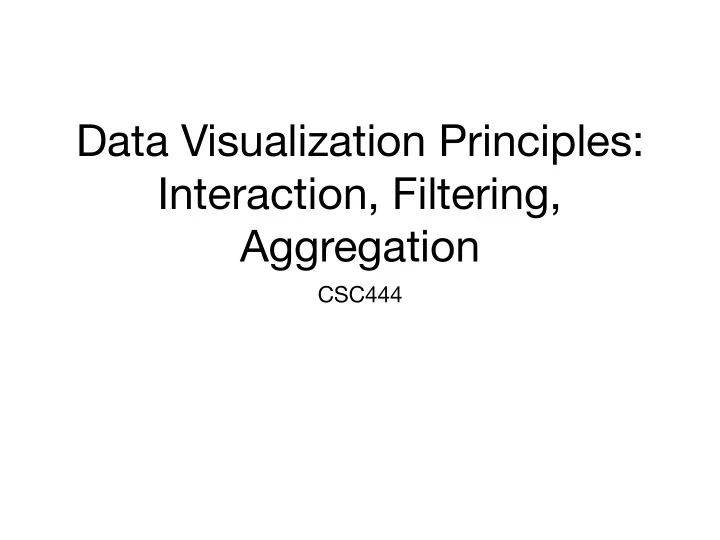

Data Visualization Principles: Interaction, Filtering, Aggregation CSC444
Announcements • Assignment 5 is due tonight • Assignment 6 is posted • Read this one early • Let’s go over a solution for Assignment 4
What if there’s too much data? • Sometimes you can’t present all the data in a single plot • Interaction : let the user drive what aspect of the data is being displayed • Filtering : Selectively hide some of the data points • Aggregation : Show visual representations of subsets of the data
Focus+Context When showing a limited view, try to hint at what is not being shown.
Demos: NYT Interactive charts http://www.nytimes.com/interactive/2014/06/05/upshot/how- the-recession-reshaped-the-economy-in-255-charts.html? abt=0002&abg=0 http://www.nytimes.com/interactive/2014/09/19/nyregion/ stop-and-frisk-map.html http://www.nytimes.com/interactive/2014/upshot/buy-rent- calculator.html?abt=0002&abg=0
INTERACTION
Fundamental idea • Interpret the state of elements in the UI as a clause in a query . As UI changes, update data Willett et al., TVCG 2007 (*)
Panning https://www.google.com/finance?q=INDEXFTSE
Zooming https://www.google.com/finance?q=INDEXFTSE
Focus+Context for Pan & Zoom Focus Context
“Geometric” “Semantic” vs. Zooming Zooming http://bl.ocks.org/mbostock/3680957
Smooth Zoom transitions (research highlight) • What’s the “best” way to go from one zoomed view to another? • Di ff erential equations to the rescue! van Wijk and Nuij, Infovis 2003 http://bl.ocks.org/mbostock/3828981
Research Highlight: smooth zoom transitions van Wijk and Nuij, Infovis 2003 http://bl.ocks.org/mbostock/3828981
Research Highlight: smooth zoom transitions … Shortest paths in zoom space! van Wijk and Nuij, Infovis 2003 http://bl.ocks.org/mbostock/3828981
FILTERING
Fundamental idea • Choose a rule, hide elements that don’t match that rule • the more complex the rule, the better you will be able to find patterns in the data. More focus • the more complex the rule, the less transparent it is, so user doesn’t know what the filtering is doing. Less context
• Case in point: do not hide outliers! • Fancy outlier detection considered harmful Schutz, CC BY-SA 3.0
Brushing, linked views • Filtering + Interaction • Show more than one view of the same data • Users drag “brushes”: regions of each view, which are interpreted directly as queries • No additional UI! http://bl.ocks.org/mbostock/4063663
AGGREGATION
Fundamental idea • If there’s too much data, replace individual data points with representation of subsets http://square.github.io/crossfilter/
Data Cubes: aggregate by collapsing attributes Multiscale Visualization using Data Cubes, Stolte et al., Infovis 2002
Data Cubes: aggregate by collapsing attributes Multiscale Visualization using Data Cubes, Stolte et al., Infovis 2002
Data Cubes: aggregate by collapsing attributes • recent: data cubes specifically designed for vis: • Bostock et al.’s Crossfilter (http://square.github.io/ crossfilter/) • Liu et al.’s Immens (http://vis.stanford.edu/papers/immens) • Lins et al.’s Nanocubes (http://nanocubes.net/) • Filtering + Aggregation + Interaction
Scented widgets (Willett et al., 2007) • If UI is necessary, summarize data on UI overlay • Filtering + Aggregation + Interaction
Research Questions • “Torture your data enough, and it’ll tell you anything”, Ronald Coase • (http://tylervigen.com/) • Statistics has tools to mitigate this problem • Interaction is much less well-studied!
Shneiderman’s “Visual information seeking mantra” Overview first, zoom and filter, then details-on-demand
Demos http://www.nytimes.com/interactive/dining/new-york- health-department-restaurant-ratings-map.html http://square.github.io/crossfilter/ http://cscheid.net/static/mlb-hall-of-fame-voting/
Overview first : Before all else, show a “high- level” view, possibly through appropriate aggregation
Zoom and Filter: Use interaction to create user-specified views
Details on Demand: Individual points or attributes should be available, but only as requested
Recommend
More recommend